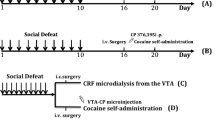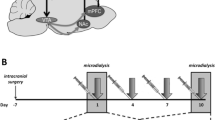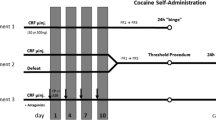Abstract
Background
Activation of corticotropin-releasing factor type 1 receptors (CRF-R1) in the ventral tegmental area (VTA) represents a critical mechanism for social defeat to escalate cocaine self-administration in adult rats.
Objective
We determined the acute effect of a CRF-R1 antagonist (CP376395) microinfusion into the VTA prior to each episode of social defeat in adolescent rats and determined whether this drug treatment could prevent later escalation of cocaine taking in early adulthood.
Methods
Rats were implanted with bilateral cannulae aimed at the VTA 5 days before the first social defeat. Bilateral microinfusion of CP376395 (500 ng/side) or vehicle occurred 20 min before each episode of social defeat on postnatal days (P) 35, 38, 41, and 44. Behavior was quantified on P35 and P44. On P57, rats were implanted with intra-jugular catheters, and subsequent cocaine self-administration was analyzed.
Results
CP376395-treated adolescent rats walked less and were attacked more slowly but were socially investigated more than vehicle-treated adolescents. Vehicle-treated rats showed increased social and decreased non-social exploration from P35 to P44, while CP376395-treated rats did not. Socially defeated, vehicle-treated adolescents took more cocaine during a 24-h unlimited access binge during adulthood. The latency to supine posture on P44 was inversely correlated with later cocaine self-administration during fixed and progressive ratio schedules of reinforcement and during the binge.
Conclusions
CP376395 treatment in adolescence blocked escalation of cocaine taking in adulthood. Episodes of social defeat stress engender neuroadaptation in CRF-R1s in the VTA that alter coping with social stress and that persist into adulthood.




Similar content being viewed by others
References
Anstrom KK, Miczek KA, Budygin EA (2009) Increased phasic dopamine signaling in the mesolimbic pathway during social defeat in rats. Neuroscience 161:3–12
Avishai-Eliner S, Yi SJ, Baram TZ (1996) Developmental profile of messenger RNA for the corticotropin-releasing hormone receptor in the rat limbic system. Brain Res Dev Brain Res 91:159–163
Blacktop JM, Seubert C, Baker DA, Ferda N, Lee G, Graf EN, Mantsch JR (2011) Augmented cocaine seeking in response to stress or CRF delivered into the ventral tegmental area following long-access self-administration is mediated by CRF receptor type 1 but not CRF receptor type 2. J Neurosci 31:11396–11403
Blanchard RJ, Blanchard DC (1977) Aggressive behavior in the rat. Behav Biol 21:197–224
Bourke CH, Glasper ER, Neigh GN (2014) SSRI or CRF antagonism partially ameliorate depressive-like behavior after adolescent social defeat. Behav Brain Res 270:295–299
Boyson CO, Miguel TT, Quadros IM, DeBold JF, Miczek KA (2011) Prevention of social stress-escalated cocaine self-administration by CRF-R1 antagonist in the rat VTA. Psychopharmacology 218:257–269
Boyson CO, Holly EN, Shimamoto A, Albrechet-Souza L, Weiner LA, DeBold JF, Miczek KA (2014) Social stress and CRF-dopamine interactions in the VTA: role in long-term escalation of cocaine self-administration. J Neurosci 34:6659–6667
Brielmaier J, McDonald CG, Smith RF (2012) Effects of acute stress on acquisition of nicotine conditioned place preference in adolescent rats: a role for corticotropin-releasing factor 1 receptors. Psychopharmacology 219:73–82
Burke AR, Miczek KA (2014) Stress in adolescence and drugs of abuse in rodent models: role of dopamine, CRF, and HPA axis. Psychopharmacology 231:1557–1580
Burke AR, Miczek KA (2015) Escalation of cocaine self-administration in adulthood after social defeat of adolescent rats: role of social experience and adaptive coping behavior. Psychopharmacology 232:3067–3079
Burke AR, Renner KJ, Forster GL, Watt MJ (2010) Adolescent social defeat alters neural, endocrine and behavioral responses to amphetamine in adult male rats. Brain Res 1352:147–156
Burke AR, Watt MJ, Forster GL (2011) Adolescent social defeat increases adult amphetamine conditioned place preference and alters D2 dopamine receptor expression. Neuroscience 197:269–279
Burke AR, Forster GL, Novick AM, Roberts CL, Watt MJ (2013) Effects of adolescent social defeat on adult amphetamine-induced locomotion and corticoaccumbal dopamine release in male rats. Neuropharmacology 67:359–369
Buwalda B, Scholte J, de Boer SF, Coppens CM, Koolhaas JM (2012) The acute glucocorticoid stress response does not differentiate between rewarding and aversive social stimuli in rats. Horm Behav 61:218–226
Buwalda B, Stubbendorff C, Zickert N, Koolhaas JM (2013) Adolescent social stress does not necessarily lead to a compromised adaptive capacity during adulthood: a study on the consequences of social stress in rats. Neuroscience 26:258–270
Chen YL, Obach RS, Braselton J, Corman ML, Forman J, Freeman J, Gallaschun RJ, Mansbach R, Schmidt AW, Sprouse JS, Tingley FD III, Winston E, Schulz DW (2008) 2-aryloxy-4-alkylaminopyridines: discovery of novel corticotropin-releasing factor 1 antagonists. J Med Chem 51:1385–1392
Chen NA, Jupp B, Sztainberg Y, Lebow M, Brown RM, Kim JH, Chen A, Lawrence AJ (2014) Knockdown of CRF1 receptors in the ventral tegmental area attenuates cue- and acute food deprivation stress-induced cocaine seeking in mice. J Neurosci 34:11560–11570
National Research Council (2011) Guide for the care and use of laboratory animals, 8th edn. National Academies Press, Washington, D.C
Covington HE 3rd, Miczek KA (2001) Repeated social-defeat stress, cocaine or morphine. Effects on behavioral sensitization and intravenous cocaine self-administration “binges”. Psychopharmacology 158:388–398
Covington HE 3rd, Miczek KA (2005) Intense cocaine self-administration after episodic social defeat stress, but not after aggressive behavior: dissociation from corticosterone activation. Psychopharmacology 183:331–340
Eghbal-Ahmadi M, Hatalski CG, Lovenberg TW, Avishai-Eliner S, Chalmers DT, Baram TZ (1998) The developmental profile of the corticotropin releasing factor receptor (CRF2) in rat brain predicts distinct age-specific functions. Brain Res Dev Brain Res 107:81–90
Grubbs FE (1969) Procedures for detecting outlying observations in samples. Technometrics 11:1–21
Heinrichs SC, Pich EM, Miczek KA, Britton KT, Koob GF (1992) Corticotropin-releasing factor antagonist reduces emotionality in socially defeated rats via direct neurotropic action. Brain Res 581:190–197
Herman JP, Figueiredo H, Mueller NK, Ulrich-Lai Y, Ostrander MM, Choi DC, Cullinan WE (2003) Central mechanisms of stress integration: hierarchical circuitry controlling hypothalamo-pituitary-adrenocortical responsiveness. Front Neuroendocrinol 24:151–180
Hoffmann JP, Cerbone FG, Su SS (2000) A growth curve analysis of stress and adolescent drug use. Subst Use Misuse 35:687–716
Holly EN, DeBold JF, Miczek KA (2015) Increased mesocorticolimbic dopamine during acute and repeated social defeat stress: modulation by corticotropin releasing factor receptors in the ventral tegmental area. Psychopharmacology 232:4469–4479
Hwa LS, Holly EN, DeBold JF, Miczek KA (2015) Social stress-escalated intermittent alcohol drinking: modulation by CRF-R1 in the ventral tegmental area and accumbal dopamine in mice. Psychopharmacology 233:681–90
Hwa LS, Shimamoto A, Kayyali T, Norman KJ, Valentino RJ, DeBold JF, Miczek KA (2016) Dissociation of μ-opioid receptor and CRF-R1 antagonist effects on escalated ethanol consumption and mPFC serotonin in C57BL/6J mice. Addict Biol 21:111–124
Insel TR, Battaglia G, Fairbanks DW, De Souza EB (1988) The ontogeny of brain receptors for corticotropin-releasing factor and the development of their functional association with adenylate cyclase. J Neurosci 8:4151–4158
Koob GF, Zorrilla EP (2010) Neurobiological mechanisms of addiction: focus on corticotropin-releasing factor. Curr Opin Investig Drugs 11:63–71
Koolhaas JM, Schuurman T, Wiepkema PR (1980) The organization of intraspecific agonistic behaviour in the rat. Prog Neurobiol 15:247–268
Lukkes JL, Norman KJ, Meda S, Andersen SL (2016) Sex differences in the ontogeny of CRF receptors during adolescent development in the dorsal raphe nucleus and ventral tegmental area. Synapse 70:125–132
Miczek KA (1979) A new test for aggression in rats without aversive stimulation: differential effects of d-amphetamine and cocaine. Psychopharmacology 60:253–259
Miczek KA, Nikulina EM, Shimamoto A, Covington HE 3rd (2011) Escalated or suppressed cocaine reward, tegmental BDNF, and accumbal dopamine caused by episodic versus continuous social stress in rats. J Neurosci 31:9848–9857
Nader J, Chauvet C, Rawas RE, Favot L, Jaber M, Thiriet N, Solinas M (2012) Loss of environmental enrichment increases vulnerability to cocaine addiction. Neuropsychopharmacology 37:1579–1587
Nansel TR, Overpeck M, Pilla RS, Ruan WJ, Simons-Morton B, Scheidt P (2001) Bullying behaviors among US youth: prevalence and association with psychosocial adjustment. JAMA 285:2094–2100
Newman ML, Holden GW, Delville Y (2005) Isolation and the stress of being bullied. J Adolesc 28:343–357
Nocjar C, Zhang J, Feng P, Panksepp J (2012) The social defeat animal model of depression shows diminished levels of orexin in mesocortical regions of the dopamine system, and of dynorphin and orexin in the hypothalamus. Neuroscience 218:138–153
Paul ED, Hale MW, Lukkes JL, Valentine MJ, Sarchet DM, Lowry CA (2011) Repeated social defeat increases reactive emotional coping behavior and alters functional responses in serotonergic neurons in the rat dorsal raphe nucleus. Physiol Behav 104:272–282
Paxinos G, Watson C (2007) The rat brain in stereotaxic coordinates, 6th edn. Academic Press/Elsevier, Amsterdam
Plyusnina IZ, Solov’eva MY, Oskina IN (2011) Effect of domestication on aggression in gray Norway rats. Behav Genet 41:583–592
Schultz W (2002) Getting formal with dopamine and reward. Neuron 36:241–263
Schulz DW, Mansbach RS, Sprouse J, Braselton JP, Collins J, Corman M, Dunaiskis A, Faraci S, Schmidt AW, Seeger T, Seymour P, Tingley FD 3rd, Winston EN, Chen YL, Heym J (1996) CP-154,526: a potent and selective nonpeptide antagonist of corticotropin releasing factor receptors. Proc Natl Acad Sci U S A 93:10477–10482
Sinha R (2009) Stress and addiction: a dynamic interplay of genes, environment, and drug intake. Biol Psychiatry 66:100–101
Specio SE, Wee S, O’Dell LE, Boutrel B, Zorrilla EP, Koob GF (2008) CRF1 receptor antagonists attenuate escalated cocaine self-administration in rats. Psychopharmacology 196:473–482
Tharp-Taylor S, Haviland A, D’Amico EJ (2009) Victimization from mental and physical bullying and substance use in early adolescence. Addict Behav 34:561–567
Tidey JW, Miczek KA (1996) Social defeat stress selectively alters mesocorticolimbic dopamine release: an in vivo microdialysis study. Brain Res 721:140–149
van den Berg CL, Hol T, Van Ree JM, Spruijt BM, Everts H, Koolhaas JM (1999) Play is indispensable for an adequate development of coping with social challenges in the rat. Dev Psychobiol 34:129–138
Veenit V, Riccio O, Sandi C (2014) CRHR1 links peripuberty stress with deficits in social and stress-coping behaviors. J Psychiatr Res 53:1–7
Viau V, Bingham B, Davis J, Lee P, Wong M (2005) Gender and puberty interact on the stress-induced activation of parvocellular neurosecretory neurons and corticotropin-releasing hormone messenger ribonucleic acid expression in the rat. Endocrinology 146:137–146
Wanat MJ, Hopf FW, Stuber GD, Phillips PE, Bonci A (2008) Corticotropin-releasing factor increases mouse ventral tegmental area dopamine neuron firing through a protein kinase C-dependent enhancement of Ih. J Physiol 586:2157–1270
Wang B, Shaham Y, Zitzman D, Azari S, Wise RA, You ZB (2005) Cocaine experience establishes control of midbrain glutamate and dopamine by corticotropin-releasing factor: a role in stress-induced relapse to drug seeking. J Neurosci 25:5389–5396
Watt MJ, Burke AR, Renner KJ, Forster GL (2009) Adolescent male rats exposed to social defeat exhibit altered anxiety behavior and limbic monoamines as adults. Behav Neurosci 123:564–576
Weathington JM, Cooke BM (2012) Corticotropin-releasing factor receptor binding in the amygdala changes across puberty in a sex-specific manner. Endocrinology 153:5701–5705
Zorrilla EP, Valdez GR, Nozulak J, Koob GF, Markou A (2002) Effects of antalarmin, a CRF type 1 receptor antagonist, on anxiety-like behavior and motor activation in the rat. Brain Res 952:188–199
Acknowledgments
The authors acknowledge the support from the National Institutes of Health R01DA031734 (KAM), F32DA032226 (ARB), Tufts University Office of the Vice Provost for Research, and Tufts University Graduate School of Arts and Sciences and thank the Tufts University undergraduate assistants Shreya Bhatia and Rebecca Nardulli.
Author information
Authors and Affiliations
Corresponding author
Ethics declarations
Facilities and procedures were approved by the Tufts Institutional Animal Care and Use Committee in adherence with the guidelines established by the National Institutes of Health (National Research Council 2011).
Conflict of interest
The authors declare that they have no conflicts of interest.
Rights and permissions
About this article
Cite this article
Burke, A.R., DeBold, J.F. & Miczek, K.A. CRF type 1 receptor antagonism in ventral tegmental area of adolescent rats during social defeat: prevention of escalated cocaine self-administration in adulthood and behavioral adaptations during adolescence. Psychopharmacology 233, 2727–2736 (2016). https://doi.org/10.1007/s00213-016-4336-4
Received:
Accepted:
Published:
Issue Date:
DOI: https://doi.org/10.1007/s00213-016-4336-4




